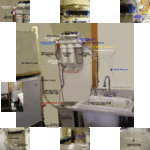I used eBay years ago and still use the same system (there is not much to break) Most use the same standardized components and I don't believe any branding makes much difference. You do want to record your GPD somewhere (like with a marker on your RO filter or back plate) so that you order the correct RO replacement cartridge.
I would recommend getting clear canister(s) for the particulate filter(s) as you can see it/them getting dirty (where you use carbon, transparency does not matter but it won't hurt and give flexibility if you want to change one to a particulate filter later) and would recommend using a clear canister style for the DI resin. Mine came with a clear cylindrical top placed unit but was rather small and difficult to fill so I replaced it with an additional, larger wall mounted canister style. I also HIGHLY recommend getting color coded tubing.
For extras, I recommend an inline TDS meter. Mine is connected to allow me to look at the incoming as well as the RO (ie before after the DI filtration). This is a good way to monitor when you need to replace the RO membrane.
I also have a 2 gallon holding tank that I recommend. I use a 20 gallon plastic storage container (flat sides are better than rounded) with a float valve for most of the water but I like the extra 2 gallons that are NOT DI. My system is setup to tap from the tank first, routing through the DI filter when it fills the holding bucket. I also have a faucet on the sink that uses the 2 gallon tank but does not route though the DI filter. I believe DI water has now been approved for drinking but it was not when I set the system up.
For spare parts, I recommend ordering a spare RO membrane, several tubing connectors, at least one spare shut off valve (added one to the exit point and it should come with one for the input side) and a spare flush valve (all but the membrane are very cheap and ordering with the unit will avoid shipping that would cost more than the parts).
You will need to have the unit near a sink/drain as the waste produced is about 4 times the water ( noticed that some of the units are now claiming a 2:1 waste ratio but that is still a lot of water) that it actually makes. I have mine in the garage with the waste tube sitting in the sink. I could have easily plumbed it to the drain but every so often it will run continuously and I need to back flush it, turn off the water for a day (using the unit's valve, not the main water supply) and then turn open the valve. If I could not see the waste water flowing into the sink, I would not be aware of the problem.
Here is a picture I labeled years ago (before replacing the DI filter) for someone who was trying to remember how to set up a system that had languished in the basement. I am not sure it is overly helpful



